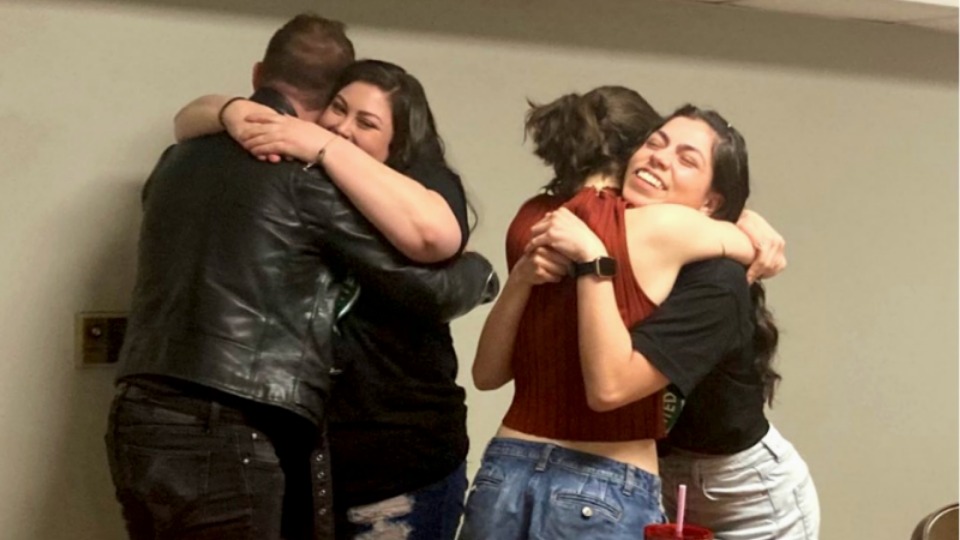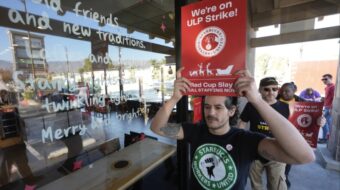
Jen Lenz is an employee at the Campustown Starbucks store in Peoria, Ill. In the article below, she shares a first-hand account of how workers successfully organized their workplace despite fierce union-busting and divisive tactics on the part of the coffee bosses.
I started at Starbucks in March 2020. My whole experience at the company has been in the context of the COVID-19 pandemic. But I’ve worked in the restaurant service industry as a whole for almost 13 years. I’m very familiar with how terrible working conditions can be across the industry, and how little benefits are offered at these kinds of jobs.
What attracted me to Starbucks was the benefits, because I know what it’s like out there. I’ve had the experience working in the “back of house” and “front of house” at restaurants, breweries, bars, and cafes—and none of these jobs have come close to giving me any benefits. Starbucks is extremely aware of this factor when it comes to attracting employees.
It brags about the benefits to bring you in. They call you “partners,” to pretend to care about you. In reality, we are workers like anyone else. They dangle the benefits just out of reach until they have exploited the labor they want out of you. Corporate gets to choose to change your benefits at any time; they can take anything away at any time.

I truly believe workers are meant to be organizers; it begins by building relationships and having conversations with your co-workers. This is important to organizing the restaurant industry; bonding with your coworkers is part of the culture when you’re all in the weeds during a shift. You’re wiping the sweat off your brow as you make eye contact with your comrade across the room. You give each other the silent nod that says, “I see you. I got your back. We got this.”
What you’re looking forward to is getting off work and having drinks with your co-workers and blowing off steam. It doesn’t matter whether you are “back of house” or “front of house” as far as job duties, it’s still the same struggle. We clock in and clock out together, all of us, the line cooks, the bartenders, the bussers, the servers—but you know who’s not there—the managers. Coffee shops and cafes have the same dynamic because we as baristas are working both “front of house” and “back of house” at the same time—same struggle.
Organizing our store
After a few months of talking to each other about working conditions and the need to do something about it, by mid-January this year the organizing process really took off. We had new faces amongst our ranks excited to do the organizing work. Within a week, we formed an organizing committee of other workers interested in taking on more and had the time and capacity to do so, and we had contacted Workers United.
We set up a meeting and they told us the next step would be to get union cards signed and to continue to educate workers about the union, answer questions, and maintain unity. To get our cards signed, we divided up our list of workers, that way no one on the committee was responsible for more than 2-3 contacts at a time. The day before the petition went public, we also filed using the Joy Silk Act, allowing for an extra layer of protection in our petition. We were able to file our petition on Feb. 11, 2022.
On that day, I finished my shift at 11 a.m., clocked out, and joined the other members of the organizing committee to hand deliver our petition to our store manager. Delivering our union petition to management was empowering. Our store manager was shocked, and they quickly disappeared to make phone calls.
We stuck around the cafe to hang out with each other and take pictures. Within minutes, our store manager came back to deliver us a policy. It was a new policy to us and was similar to the new policy that was thrown at the Memphis 7 about “partner use” of social media. On Feb. 18, all shift supervisors, including myself, were told by our store manager that effective immediately we could no longer use text messages as a form of communication with our store manager, and they will no longer be using text to communicate with us. Phone calls only.
This wasn’t a big deal for us. We didn’t have any interest in answering a phone call from a manager anyway if we weren’t at work. We were informed that any phone calls with management while off the clock would be reimbursed and paid by the minute, but again, workers don’t want to talk on the phone with their manager on their day off.
The new policy was presented verbally, and our store manager could not provide us with any official written documentation to verify it. When I pressed for more information, my manager said, “I’m just doing what I’ve been told for my protection.” Translation: Starbucks doesn’t want a text or paper trail of managers abusing communications with their employees. They didn’t want to be caught saying something they shouldn’t for legal protection.
By Feb. 21, the organizing committee had met with our own legal representation and worked with an attorney to prepare for our NLRB (National Labor Relations Board) hearing. The NLRB hearing was requested by Starbucks because they refused to voluntarily recognize our petition to unionize and instead wanted to open voting to all 16 stores in the marketing district, even though only one store was petitioning to unionize.
This was an attempt to suppress our vote and our voice. We were confident, however. Every NLRB hearing between a single store’s workers and Starbucks was won by the workers. The NLRB had repeatedly denied every request from Starbucks because of lack of evidence. Our NLRB hearing was scheduled for March 8.
Our store, Campustown Starbucks, was paired with another petitioning store in Cary, Ill., to also be present at the same hearing. I and another co-worker from the organizing committee were issued subpoenas to testify in court on behalf of the workers. But suddenly, on the morning of March 8, Starbucks conceded. A few minutes before the hearing, they agreed to allow separate elections for each of our stores, calling it a “stipulation agreement.” Starbucks agreed to the timeline of dates for the ballot mailing on April 5 and ballot count on April 26.
On March 16, our district manager came to our store first thing in the morning. Already my co-workers and I were suspicious of the intentions behind this random visit. It turned out to be the first session of union-busting meetings. We called them union-busting meetings. Starbucks called them “1:1 Hearing Sessions.” They would continue every week until the vote was over.
The day continued with multiple disruptions to our daily routines. Management continually pulled workers off the floor to give them the union-busting routing, which of course hurt the rest of the workers left on the shop floor without enough support to keep up with business.
At the end of our shift, my co-worker who also received a subpoena for the hearing was taken into a disciplinary meeting with the district manager and store manager. They were given an official write-up for missing work on the day the NLRB hearing began (March 8). This write-up was unprecedented; we had given management a 10-day notice that we had been subpoenaed to be in court for the hearing. Starbucks was the one taking us to court, where we were legally subpoenaed to be present, yet Starbucks tried to punish us for not being at work at the same time.
My co-worker and I immediately got in touch with the attorney provided to us by the union and confirmed this indeed was considered an Unfair Labor Practice (ULP). We filed a ULP for this and are still waiting to hear how the NLRB will rule in the case.
When ballots were mailed April 5, we were relieved; we thought we were ready. We had anticipated the union-busting to increase during this time, but we had no idea how much damage control it would require. Starbucks was strategic. They had given up on most of the members of the organizing committee and focused on singling out the college students who would be transferring out soon to other stores when school ended for the semester.
Despite everything we had done to prepare students for the scare tactics and threats of not being able to transfer, there was a week when every student had switched sides because of fear and intimidation. We had two newer members from the organizing committee who were also students; this saved the unionization efforts. They were able to come to the rest of the organizing committee and tell us exactly what was being said in their union-busting meetings. We addressed concerns as quickly as we could, but it didn’t seem to be enough to convince the other students.
We talked about how we could prove to the team that what Starbucks was telling them was all lies, and it would be illegal for them to deny a transfer. So we landed on filing another ULP. We also wanted to test management on their threats of denying transfers and see if we could poke holes in the web of lies they had created. One of the organizing students filled out their transfer papers and brought it in to the store, confronted the store manager, and asked them to sign. When the store manager denied the transfer papers to their face, we had what we needed to file the ULP.

We immediately wrote a transcript, recording the entire interaction, including witnesses, and contacted our attorney. Within a few days, our district manager arrived and pulled the organizing student aside and apologized about what had happened with the store manager, and agreed to sign the transfer documentation. The district manager wasn’t doing this to be nice; they had an agenda. They told the student they could sign the papers, but only after calling every store in the district the student was transferring to and reporting that they were coming from a union store.
Regardless, this validated our belief that their threats were nonsense and lies. The students were allowed to request their transfers after we challenged management on the issue. However, we faced another problem. The receiving stores in the district of transfers don’t want to accept transfers from a union store because they are worried our radical ideas and organizing will spread to new stores. It’s true, we have every intention of organizing workers into new districts—but these attempts to deny acceptance of the transfer on the receiving end are also illegal, and we have filed yet another ULP. We’re still waiting on the NLRB to rule on this matter, too.
In a last attempt to suppress our celebration on the day of the ballot count, Starbucks issued a request to the NLRB to only allow one observer from each side to be present for the ballot challenging portion. The NLRB allowed the request. This could be a new tactic from Starbucks to help reign in the narrative by withholding the ballot viewing process from the workers who fought to unionize. Starbucks doesn’t want to see employees happy when the union wins, and the company certainly doesn’t want the images of victory to inspire other workers to unionize. So far, Campustown and Cary, Ill., have been the only stores in the nation for this incident to occur.
Despite Starbucks throwing everything at us to quell our unionization efforts and celebration, we remained a united front. The organizing movement is not slowing down, and Starbucks workers continue to win their union elections wherever they happen. We are building power from within and sharing our experiences with our comrades across the country. All workers need to be organizing to build power to take on their employer.
Our ballot count was April 26, and we came through victorious with a win of 9-2, and a win for Cary at 17-4. For the first time in history, there are now two fully unionized stores in Illinois, and more to come.
Support the effort with a donation here: https://bit.ly/peoriasbuxworkers
For more local updates, follow the author on Twitter: @JenLenz
For national updates, follow: @SBWorkersUnited










